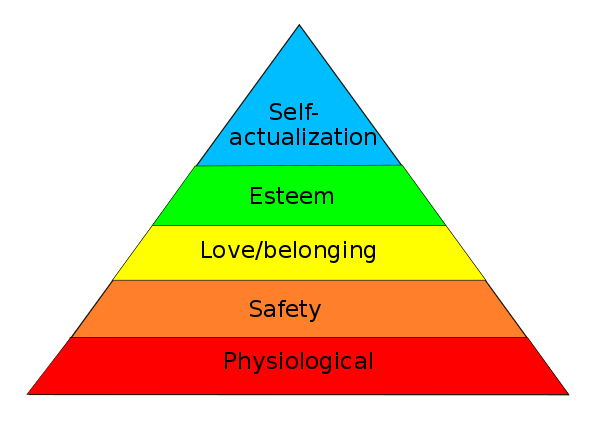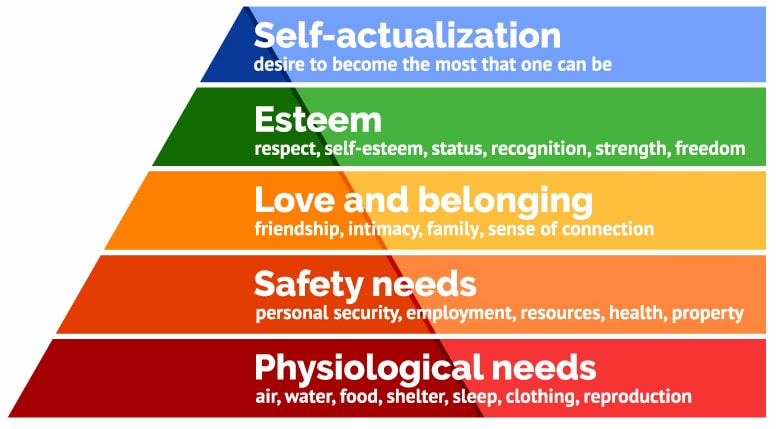A need is something that is necessary for an organism to live a healthy life and to grow into full fruition. Needs are distinguished from wants and means in that, in the case of a need, a deficiency causes a clear adverse outcome: a deprivation, an arrest in development, a dysfunction or death.
In other words, a need is something required for a safe, stable, healthy, complete life in fullness while a want is a desire, wish or aspiration. And means are the approaches, substances, methods or tactics one applies to satisfy the need.
In the ideally healthy and functional human psyche:
- one is completely clear about one’s needs on all dimensions in every present moment,
- one aligns his/her wants with fulfilling those needs,
- one creatively finds the most optimal, ecological and effective means to fulfill them, and
- acts upon these wants with integrity.
Universal human needs
Human needs are universal while the means and strategies to meet the universal needs can be individually, culturally and socially very diverse. Several researchers have proposed interesting models to identify the human needs. You find a selection of models here below. The IP practitioner uses these models simply as a source of inspiration and a support to help to recognize and identify true needs. The IP philosophy wants to keep need management practical rather then academic.
Maslow’s hierarchy of needs
Maslow’s hierarchy of needs is a theory in psychology proposed by Abraham Maslow in his 1943 paper “A Theory of Human Motivation” in Psychological Review. Maslow used the terms “physiological”, “safety”, “belonging and love”, “esteem”, “self-actualization”, and “self-transcendence” to describe the pattern through which human motivations generally move. The goal of Maslow’s Theory is to attain the sixth level or stage: self-transcendence.

1. Physiological needs – these are biological requirements for human survival, e.g. air, food, drink, shelter, clothing, warmth, sex, sleep.
If these needs are not satisfied the human body cannot function optimally. Maslow considered physiological needs the most important as all the other needs become secondary until these needs are met.
2. Safety needs – protection from elements, security, order, law, stability, freedom from fear.
3. Love and belongingness needs – after physiological and safety needs have been fulfilled, the third level of human needs is social and involves feelings of belongingness. The need for interpersonal relationships motivates behavior
Examples include friendship, intimacy, trust, and acceptance, receiving and giving affection and love. Affiliating, being part of a group (family, friends, work).
4. Esteem needs – which Maslow classified into two categories: (i) esteem for oneself (dignity, achievement, mastery, independence) and (ii) the desire for reputation or respect from others (e.g., status, prestige).
Maslow indicated that the need for respect or reputation is most important for children and adolescents and precedes real self-esteem or dignity.
5. Self-actualization needs – realizing personal potential, self-fulfillment, seeking personal growth and peak experiences. A desire “to become everything one is capable of becoming”.

Needs in NVC
Marshall Rosenberg’s model of Compassionate Communication, also known as Nonviolent Communication (NVC) makes the distinction between universal human needs (what sustains and motivates human life) and specific strategies used to meet these needs (means). Feelings are seen as neither good nor bad, right nor wrong, but as indicators of when human needs are met or unmet. Life-sustaining and life-denying needs are especially highlighted. In contrast to Maslow, Rosenberg’s model does not place needs in a hierarchy.
The NVC list of needs:
CONNECTION
acceptance
affection
appreciation
belonging
cooperation
communication
closeness
community
companionship
compassion
consideration
consistency
empathy
inclusion
intimacy
love
mutuality
nurturing
respect/self-respect
CONNECTION continued
safety
security
stability
support
to know and be known
to see and be seen
to understand and
be understood
trust
warmth
PHYSICAL WELL-BEING
air
food
movement/exercise
rest/sleep
sexual expression
safety
shelter
touch
water
HONESTY
authenticity
integrity
presence
PLAY
joy
humor
PEACE
beauty
communion
ease
equality
harmony
inspiration
order
AUTONOMY
choice
freedom
independence
space
spontaneity
MEANING
awareness
celebration of life
challenge
clarity
competence
consciousness
contribution
creativity
discovery
efficacy
effectiveness
growth
hope
learning
mourning
participation
purpose
self-expression
stimulation
to matter
understanding
Fundamental human needs
This model developed by Manfred Max-Neef also considers needs as universal as well as being few, finite (9 to be concrete) and classifiable. Max-Neef also regards them as distinct from wants which are potentially infinite and and therefor insatiable. In this model needs are understood in a system and are therefor interrelated and interactive and not hierarchical as in Maslow’s model.
Yet Max-Neef agrees that human needs are universal and thus constant, not only through all human cultures but also across historical time periods. What changes between cultures and over time is the means by which these needs (and additionally created desires) are satisfied but not the actual needs.
Max-Neef classifies the 9 fundamental human needs as:
Subsistence
Protection
Affection
Understanding
Participation
Leisure
Creation
Identity
Freedom
In this approach needs are also defined according to the existential categories of being, having, doing and interacting, and from these dimensions, a 36 cell matrix is developed.
| Need | Being (qualities) | Having (things) | Doing (actions) | Interacting (settings) |
|---|---|---|---|---|
| Subsistence | physical and mental health | food, shelter, work | feed, clothe, rest, work | living environment, social setting |
| Protection | care, adaptability, autonomy | social security, health systems, work | co-operate, plan, take care of, help | social environment, dwelling |
| Affection | respect, sense of humour, generosity, sensuality | friendships, family, relationships with nature | share, take care of, express emotions | privacy, intimate spaces of togetherness |
| Understanding | critical capacity, curiosity, intuition | literature, teachers, policies, educational | analyse, study, meditate, investigate, | schools, families, universities, communities |
| Participation | receptiveness, dedication, sense of humour | responsibilities, duties, work, rights | cooperate, dissent, express opinions | associations, parties, churches, neighbourhoods |
| Leisure | imagination, tranquility, spontaneity | games, parties, peace of mind | day-dream, remember, relax, have fun | landscapes, intimate spaces, places to be alone |
| Creation | imagination, boldness, inventiveness, curiosity | abilities, skills, work, techniques | invent, build, design, work, compose, interpret | spaces for expression, workshops, audiences |
| Identity | sense of belonging, self-esteem, consistency | language, religions, work, customs, values, norms | get to know oneself, grow, commit oneself | places one belongs to, everyday settings |
| Freedom | autonomy, passion, self-esteem, open-mindedness | equal rights | dissent, choose, run risks, develop awareness | anywhere |
Challenges
With the ideal definition of need management above, it becomes quite clear that several aspects can be hindered along the way, such as:
not knowing or feeling one’s needs
having confusion about one’s needs
not admitting one’s needs
believing to have conflicting needs
excessive neediness versus true needs
not giving oneself permission to have needs
feeling guilt to have needs
knowing one’s needs only partially
having false needs
…
mismatch between wants and needs
desiring the opposite or something completely different then what one needs
laziness / not wanting to take responsibility for one’s needs
codependency: an excessive reliance on other people
abuse: letting someone else take care of one’s needs in an dishonest exchange
distracted wants, wanting things one does not need
…
not knowing how to fulfill the needs
using the wrong means or approaches for certain needs
using (or believing the necessity of) means that are out of proportion with the actual need
using phantasies as a substitute for true means
pessimism: believing in the impossibility or in an insurmountable challenge of fulfilling true needs
rigidity: being fixated in one certain way to get one’s need fulfilled and blocking out the unlimited possibilities of the present moment
…
not acting upon one’s appropriate desires (desires aligned with accessible means with realistic potential for satisfying true needs)
disproportionate will power (lack or excess): working too little or too hard for a certain need
loss of integrity: dishonest strategies to get what one wants
selling oneself out: not respecting one’s own integrity
giving / paying too much or too little for what one gets
…
Satisfyers
Max-Neef further classifies Satisfiers (ways of meeting needs – means) as follows.
Violators: claim to be satisfying needs, yet in fact make it more difficult to satisfy a need. E.g. drinking a soda advertised to quench your thirst, but the ingredients (such as caffeine or sodiumsalts) cause you to urinate more, leaving you less hydrated on net.
Pseudo Satisfiers: claim to be satisfying a need, yet in fact have little to no effect on really meeting such a need. For example, status symbols may help identify one’s self initially, but there is always the potential to get absorbed in them and forget who you are without them.
Inhibiting Satisfiers: those that over-satisfy a given need, which in turn seriously inhibits the possibility of satisfaction of other needs. Mostly originating in deep-rooted customs, habits and rituals. For example, an overprotective family stifles identity, freedom, understanding, and affection.
Singular Satisfiers: satisfy one particular need only. These are neutral in regard to the satisfaction of other needs. For those who do not have the means to find singular satisfiers under their presiding socioeconomic conditions, singular satisfiers are often institutionalized by voluntary, private sector, or government programs. For example, food/housing volunteer programs aid in satisfying subsistence for less fortunate people.
Synergistic Satisfiers: satisfy a given need, while simultaneously contributing to the satisfaction of other needs. These are anti-authoritarian and represent a reversal of predominant values of competition and greed. For example, breast feeding gives a child subsistence, and aids in the development in protection, affection, and identity.
